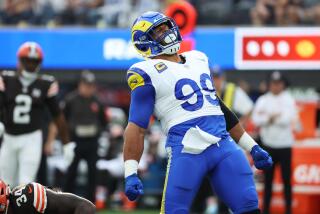Ollie Matson dies at 80; NFL Hall of Famer played on some of the worst Rams teams
Ollie Matson, a remarkably versatile football player who had the misfortune during a 14-year career in the National Football League to play on mostly bad teams, among them some of the worst Los Angeles Rams clubs in history — and made it to the Hall of Fame anyway — has died. He was 80.
FOR THE RECORD:
Ollie Matson: In the obituary of Hall of Fame football player Ollie Matson in the Feb. 20 LATExtra section, the last name of his former college teammate Bob St. Clair was misspelled as St. Claire. —
Matson died of respiratory failure Saturday at his Los Angeles home, said his nephew, Art Thompson III. He had been in home hospice care for the past week and had suffered from dementia for several years.
He blocked, caught passes — he threw a few as well — and, early in his career, played defense as well as offense. But Matson, thanks to his Olympic-caliber speed, was known for his breakaway running with the ball — from scrimmage, after catching passes or on kickoff and punt returns. Averaging 4.4 yards, he rushed for 5,173 yards, caught 222 passes for 3,285 yards and altogether gained 12,884 yards on rushes, receptions and returns.
He scored 40 touchdowns running from scrimmage, 23 on receptions, nine on returns — including a 105-yard kickoff return against the Washington Redskins in 1956 — and one on a fumble recovery. And for all of that, in only two of his 14 seasons with the Chicago Cardinals, Rams, Detroit Lions and Philadelphia Eagles did his team finish above .500.
He was NFL rookie of the year in 1952 and All-NFL four times. He was selected to play in six Pro Bowl games — winning the Most Valuable Player award in one — and was so desired by the Rams that in 1959 they traded eight players and a draft choice to get him, and him alone, from the Cardinals. Yet he never got close to playing in a championship game.
In a way, Matson’s NFL career was an extension of his college career at the University of San Francisco. There, he rushed for an NCAA-record 3,166 yards in three years as a starter and, as a senior, led the Dons to a 9-0 record, only to see the team snubbed when bowl invitations were issued and his offensive achievements dismissed in All-American selections. He led the nation with 1,566 yards rushing and 21 touchdowns in 1951, yet he finished ninth in the Heisman Trophy voting and was recognized only as a defensive back on All-American teams.
Matson, though, never saw his career as anything but positive. “I’m just thrilled to have been able to accomplish so much,” he told the South Bend (Ind.) Tribune in 2004. “I remember everything so vividly, all the work and the people who helped me along the way.”
And the man who had accomplished so much — besides his football success, he won silver and bronze track medals in the 1952 Summer Olympics in Helsinki — was proudest of his 50-plus years of marriage to Mary L. Paige. “It’s all about marriage,” he said. “That’s the key right there. That’s what makes everything else feel so nice.”
Ollie Genoa Matson II was born May 1, 1930, in Trinity, Texas, and moved with his mother, Gertrude, a schoolteacher, to San Francisco when he was a teenager. After starring in football and track at Washington High School, he played for a season at San Francisco City College, scoring 19 touchdowns. He then moved on to USF, joining other future NFL Hall of Famers Gino Marchetti ( Baltimore Colts) and Bob St. Claire ( San Francisco 49ers).
Nobody knew it at the time, but the ’51 team — “undefeated, untied and uninvited” and “the best team you never heard of” — was destined to be USF’s last gasp in football. Although the Dons had played a major-college schedule in previous seasons, some of those opponents, notably Cal and Stanford, dropped the Dons when they improved. As a result, USF had to fill its schedule as best it could, playing Idaho, San Jose State twice, the Camp Pendleton Marines and the San Diego Naval Training Center, among other teams.
The Dons outscored opponents by an average of 31 to 8; Matson, in a game against Fordham, twice muffed kickoffs, only to pick up the ball each time and run more than 90 yards for a touchdown. And in a game that was supposed to seal a bowl bid, USF throttled College of the Pacific, 47-14.
Recalled Marchetti in the Contra Costa Times, “I played on a lot of great teams [his Colts won NFL championships in 1958 and ‘59], but the best one I ever played on was the one at USF.”
There was speculation that the Dons might play in the Orange Bowl game, but Coach Joe Kuharich told his players that, in informal discussions, he’d learned that if an invitation were issued, it would be for the team’s white players only, excluding Matson and Burl Toler, the team’s other African American.
“We were shocked,” St. Claire said. “We didn’t even vote on such a stupid request.”
Two of the other major bowls, the Cotton and Sugar, also were played in the South, where integrated teams weren’t welcome, and the Rose Bowl was tied to the Big Ten and Pacific Coast Conference. So the Dons stayed home on New Year’s Day 1952, and USF, unable to make up a $70,000 football deficit, shortly thereafter dropped the sport.
Matson went on to great things in the NFL, but first he had an Olympics obligation. Although the Cardinals had made him their top draft pick, he delayed signing so as to retain his amateur status. In Helsinki, he ran a leg on the United States’ silver-medal-winning 1,600-meter relay team and finished third in the 400-meter run.
Matson was expected to lead the Cardinals out of pro football’s abyss. As good as he was, he couldn’t do that. And as eager as the Rams were to get Matson, once they had him they didn’t know what to do with him. Under three head coaches in four seasons, Matson played tailback, fullback, slotback and flanker. After gaining 883 yards his first season with the Rams, he never again approached that figure. In 1962, his last season in L.A., he was a reserve who ran the ball three times for no yardage on a team that finished 1-12-1. In Matson’s four seasons with the Rams, they went 11-39-2.
He played one season with the Detroit Lions and three with the Philadelphia Eagles before retiring in 1966. Matson later worked as an NFL scout, coached high school and college football and served on the Los Angeles Memorial Coliseum Commission. He was inducted into the Pro Football Hall of Fame in 1972 and the College Football Hall of Fame in 1976.
Matson is survived by his twin sister, Ocie Thompson of Oakland; children Ollie III of Baltimore, Bruce of Houston, Lisa Lewis of Los Angeles and Barbara King of Oklahoma; eight grandchildren; and two great-grandchildren. Services are pending.
Kupper is a former Times staff writer.
More to Read
Start your day right
Sign up for Essential California for the L.A. Times biggest news, features and recommendations in your inbox six days a week.
You may occasionally receive promotional content from the Los Angeles Times.






